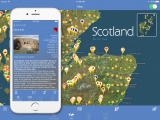<< Our Photo Pages >> St Albans Puddingstones - Natural Stone / Erratic / Other Natural Feature in England in Hertfordshire
Submitted by willowman1 on Thursday, 05 January 2017 Page Views: 10657
Natural PlacesSite Name: St Albans PuddingstonesCountry: England County: Hertfordshire Type: Natural Stone / Erratic / Other Natural Feature
Nearest Town: St Albans
Map Ref: TL139075
Latitude: 51.754619N Longitude: 0.351276W
Condition:
| 5 | Perfect |
| 4 | Almost Perfect |
| 3 | Reasonable but with some damage |
| 2 | Ruined but still recognisable as an ancient site |
| 1 | Pretty much destroyed, possibly visible as crop marks |
| 0 | No data. |
| -1 | Completely destroyed |
| 5 | Superb |
| 4 | Good |
| 3 | Ordinary |
| 2 | Not Good |
| 1 | Awful |
| 0 | No data. |
| 5 | Can be driven to, probably with disabled access |
| 4 | Short walk on a footpath |
| 3 | Requiring a bit more of a walk |
| 2 | A long walk |
| 1 | In the middle of nowhere, a nightmare to find |
| 0 | No data. |
| 5 | co-ordinates taken by GPS or official recorded co-ordinates |
| 4 | co-ordinates scaled from a detailed map |
| 3 | co-ordinates scaled from a bad map |
| 2 | co-ordinates of the nearest village |
| 1 | co-ordinates of the nearest town |
| 0 | no data |
Internal Links:
External Links:
I have visited· I would like to visit
willowman1 visited on 22nd Sep 2017 - their rating: Cond: 5 Amb: 3 Access: 4
Numbers refer to the Puddingstone Trail. OS map refs of sites No. 61 to 67 are TL158069; TL154071; TL151070; TL149071; TL143074; TL 141074.
Page originally by Thorgrim
Note: Archive photos of the St Albans Puddingstones which Mike Burgess (Willowman1) has been researching.
You may be viewing yesterday's version of this page. To see the most up to date information please register for a free account.






Do not use the above information on other web sites or publications without permission of the contributor.
Click here to see more info for this site
Nearby sites
Key: Red: member's photo, Blue: 3rd party photo, Yellow: other image, Green: no photo - please go there and take one, Grey: site destroyed
Download sites to:
KML (Google Earth)
GPX (GPS waypoints)
CSV (Garmin/Navman)
CSV (Excel)
To unlock full downloads you need to sign up as a Contributory Member. Otherwise downloads are limited to 50 sites.
Turn off the page maps and other distractions
Nearby sites listing. In the following links * = Image available
508m W 260° Verulamium Puddingstone Natural Stone / Erratic / Other Natural Feature (TL134074)
1.1km SE 139° Holy Well (St. Albans)* Holy Well or Sacred Spring (TL14640670)
1.8km WNW 301° Devil's Ditch (Hertfordshire) Ancient Village or Settlement (TL123084)
2.4km NE 43° Beech Bottom Dyke* Ancient Village or Settlement (TL155093)
3.2km SW 226° Potterscrouch Puddingstones Natural Stone / Erratic / Other Natural Feature (TL116052)
5.2km ESE 108° Tyttenhanger Puddingstones Natural Stone / Erratic / Other Natural Feature (TL189060)
5.8km NW 312° The Aubreys* Hillfort (TL095113)
6.0km WSW 241° Bedmond Puddingstone Natural Stone / Erratic / Other Natural Feature (TL087045)
7.5km NE 40° Devil's Dyke (Hertfordshire)* Ancient Village or Settlement (TL186133)
9.1km WSW 251° Kings Langley Cursus Cursus (TL0535804425)
10.3km E 79° Mill Green Museum Museum (TL240097)
11.2km WSW 237° Chipperfield Common Round Barrows* Round Barrow(s) (TL04620126)
11.3km SSW 205° Cassiobury Park barrow* Round Barrow(s) (TQ094971)
11.4km WSW 245° Towerhill (Herts) Puddingstone* Natural Stone / Erratic / Other Natural Feature (TL0363802375)
11.6km WNW 290° Great Gaddesden Puddingstone* Natural Stone / Erratic / Other Natural Feature (TL029112)
11.6km WNW 290° Great Gaddesden church puddingstones* Natural Stone / Erratic / Other Natural Feature (TL02871127)
12.4km E 95° Wildhill Puddingstone Natural Stone / Erratic / Other Natural Feature (TL263067)
12.6km NE 48° Welwyn Puddingstone* Natural Stone / Erratic / Other Natural Feature (TL231162)
12.7km ESE 121° Potters Bar Museum Museum (TL2494101262)
12.8km NE 49° Welwyn Roman Baths* Ancient Village or Settlement (TL23451602)
13.5km SW 229° Church Hill puddingstones Natural Stone / Erratic / Other Natural Feature (TQ03899840)
13.8km S 173° Stanmore common barrows Misc. Earthwork (TQ15869381)
13.9km ESE 109° Griffin's Hole* Holy Well or Sacred Spring (TL2720403249)
14.6km WSW 257° Whelpley Hill* Hillfort (SP99680397)
15.2km S 183° Grim's Ditch (Greater London) Ancient Village or Settlement (TQ134923)
View more nearby sites and additional images






 We would like to know more about this location. Please feel free to add a brief description and any relevant information in your own language.
We would like to know more about this location. Please feel free to add a brief description and any relevant information in your own language. Wir möchten mehr über diese Stätte erfahren. Bitte zögern Sie nicht, eine kurze Beschreibung und relevante Informationen in Deutsch hinzuzufügen.
Wir möchten mehr über diese Stätte erfahren. Bitte zögern Sie nicht, eine kurze Beschreibung und relevante Informationen in Deutsch hinzuzufügen. Nous aimerions en savoir encore un peu sur les lieux. S'il vous plaît n'hesitez pas à ajouter une courte description et tous les renseignements pertinents dans votre propre langue.
Nous aimerions en savoir encore un peu sur les lieux. S'il vous plaît n'hesitez pas à ajouter une courte description et tous les renseignements pertinents dans votre propre langue. Quisieramos informarnos un poco más de las lugares. No dude en añadir una breve descripción y otros datos relevantes en su propio idioma.
Quisieramos informarnos un poco más de las lugares. No dude en añadir una breve descripción y otros datos relevantes en su propio idioma.